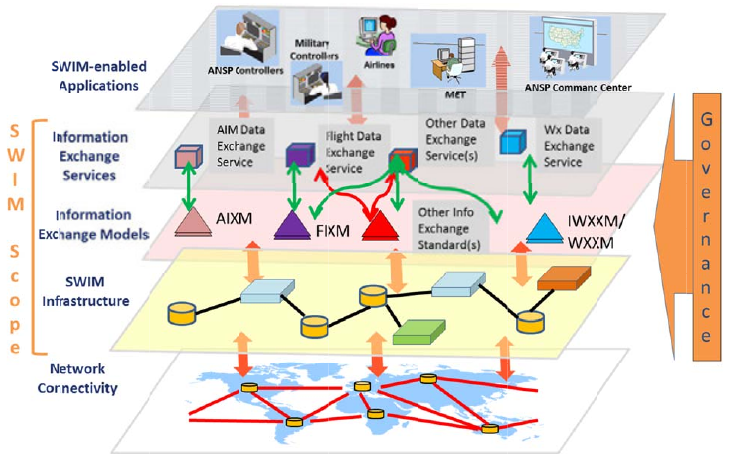Aviation | Emerging Issues | WIS and SWIM
WMO Information System (WIS)
The WMO Information system (WIS) is a single, coordinated global infrastructure comprising telecommunications and data management functions that enables the universal availability of basic meteorological and climatological data and products across WMO Members. The data and derived products are available and exchanged freely and in an unrestricted manner every day between meteorological offices and centres in each country. They are provided quickly and efficiently, using the latest information and communication technologies.
Building on the WMO Global telecommunication System (GTS) and utilizing standard elements, the WIS has been designed to dramatically extend WMO Members' ability to collect and disseminate data and products. Owned and operated by Members, it is a core information system utilized by the WMO community, providing linkages for all WMO supported programmes associated with weather, climate, water and related natural disasters.

WIS is an enhanced information system capable of exchanging large data volumes, such as new ground- and satellite-based systems, finer resolutions in numerical weather prediction and hydrological models and their applications. These data and products are available to national meteorological and hydrological services (NMHS) as well as national disaster authorities and other concerned for more timely alerts wherever and whenever. WIS is the vital data communications backbone integrating the diverse real-time and non-real-time high-priority data sets, regardless of location.
The components of the WIS are as follows:
- WIS Centres responsible for publishing data are designated either as a National Centre (NC) or a Data Collection and Production Centre (DCPC). The Centres are similar but the latter are affiliated with a WMO Programme rather than a national activity.
- Global Information System Centres (GISC) are network hubs that maintain synchronized copies of the WIS Catalogue, provide a portal to search the WIS Catalogue, maintain a cache of data and products for near-real-time exchange between operational centres and offer mechanisms to download or subscribe to data and products within the cache. It is important to note that this "global cache" represents a very small subset of the data that is discoverable on WIS.
GISCs and DCPCs are required to demonstrate, through independent audit, their capability to meet the relevant WMO technical regulations. These constraints ensure that WIS remains an authoritative source of meteorological and hydrological data.
Further information on the WIS is published in WMO-No. 1060, Manual on the WMO Information System (regulatory) and WMO-No. 1061, Guide to the WMO Information System (non-regulatory).
ICAO System-Wide Information Management (SWIM)
With the expected growth in aviation demand, economic pressures and attention to environmental impact, the air traffic management (ATM) system will be increasingly reliant on accurate and timely information, including meteorological information. Such information must be organized and provided by solutions that support system-wide interoperability and secured seamless information access and exchange. As today's ATM systems suffer from defaults and constraints that make the global system not efficient enough and at a significant cost, global improvements in information management are needed in order to integrate the ATM network for a performance-enhancing operational scenario. These improvements are envisioned to be applied on a system-wide information management (SWIM) basis.
The Global Air Traffic Management (ATM) Operational Concept (ICAO Doc 9854) envisages the application of SWIM to promote information-based ATM integration, stated as follows:
"The ATM operational concept envisages the application of a system-wide information management concept, where information management solutions will be defined at the overall system level, rather than individually at each major subsystem (programme/ project/ process/function) and interface level, as has happened in the past."
Implementation of the SWIM Concept must address the challenge of creating an “interoperability environment” which allows the SWIM systems to cope with the full complexity of operational information exchanges. The SWIM Concept introduces a significant change in the business practices of managing information during the entire life cycle of an ATM process. The implementation of SWIM seeks to provide the right quality information to the right people with the right systems at the right time. The SWIM environment shifts the ATM information architecture paradigm from point-to-point data exchanges to system-wide interoperability.
SWIM is not meant to be a stand-alone concept. The justification for its development and deployment lies in the needs of its client applications which, although not part of SWIM, are the primary users thereof. SWIM conveys the requirements of the operational ATM services through applications that define the scope and quality of the information. Interoperability is achieved on a global scale through the use of common information exchange models for information elements of interest, the use of common services for information exchange, and the use of appropriate technology and standards.
These models for ATM information have been defined in harmonized conceptual and logical data models. The models describe the data used in different information domains such as aeronautical, flight, meteorology, and surveillance domains. They also describe logical format and structure of the data elements that make up these domains. Similarly, a definition of information services is necessary to indicate what types of services are provided, their behaviour, their performance levels and ways they can be accessed.
SWIM operates over an interoperable (runtime) infrastructure (ground/ground and air/ground) through which the data and information will be distributed. Its implementation may, depending on the specific needs profile, differ from one stakeholder to another, both in terms of scope and method of implementation. Typically, dedicated and secured IP networks and the Internet will provide the underlying basic ground/ground connectivity.

The sharing of information via the SWIM is described in the five-layered SWIM Global Interoperability Framework (see figure above), comprising the following layers:
- SWIM-enabled Applications of information providers and information consumers around the globe.
- Information Exchange Services: the SWIM-enabled applications will use information exchange services for interaction.
- Information Exchange Models: using subject-specific standards for sharing information for the above Information Exchange Services. The information exchange models define the syntax and semantics of the data exchanged by applications; they are built on several standardised data model components, including the GML component. This is where the ICAO meteorological Information exchange model (IWXXM) resides along with the other weather exchange model (WXXM) which is an extension of IWXXM defined and governed by the United States FAA, Eurocontrol and others.
- SWIM Infrastructure for sharing information: provides the core services such as interface management, request-reply and publish-subscribe messaging, service security, and enterprise service management.
- Network Connectivity: provides consolidated telecommunications services, including hardware. This infrastructure is a collection of the interconnected network infrastructures of the different stakeholders. These will be private/public Internet Protocol (IP) networks.
The scope of SWIM is limited to the three middle layers, namely Information Exchange Services, Information Exchange Models, and SWIM Infrastructure – and to the governance of these layers.
At the information exchange models layers, the characteristics of the data being used by the information exchange services are described to include information content, structure and format. The combined information exchange services and the information exchange models layers define individual application-level messages that can be exchanged to deliver the requested services.
The application of SWIM in support of the global ATM operational concept was further reinforced in ICAO Doc 9882, Manual on Air Traffic Management System Requirements. Moreover, SWIM is an integral part of the ICAO Doc 9750, Global Air Navigation Plan (GANP) and is covered in a number of the GANP’s aviation system block upgrades (ASBU) modules.
CLICK HERE to return to our homepage

